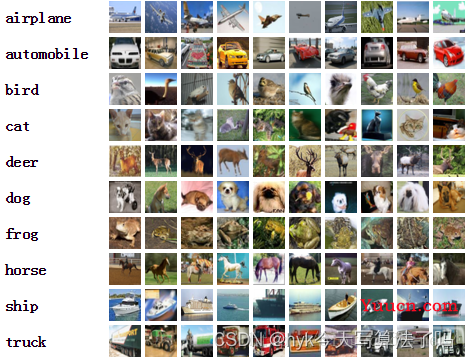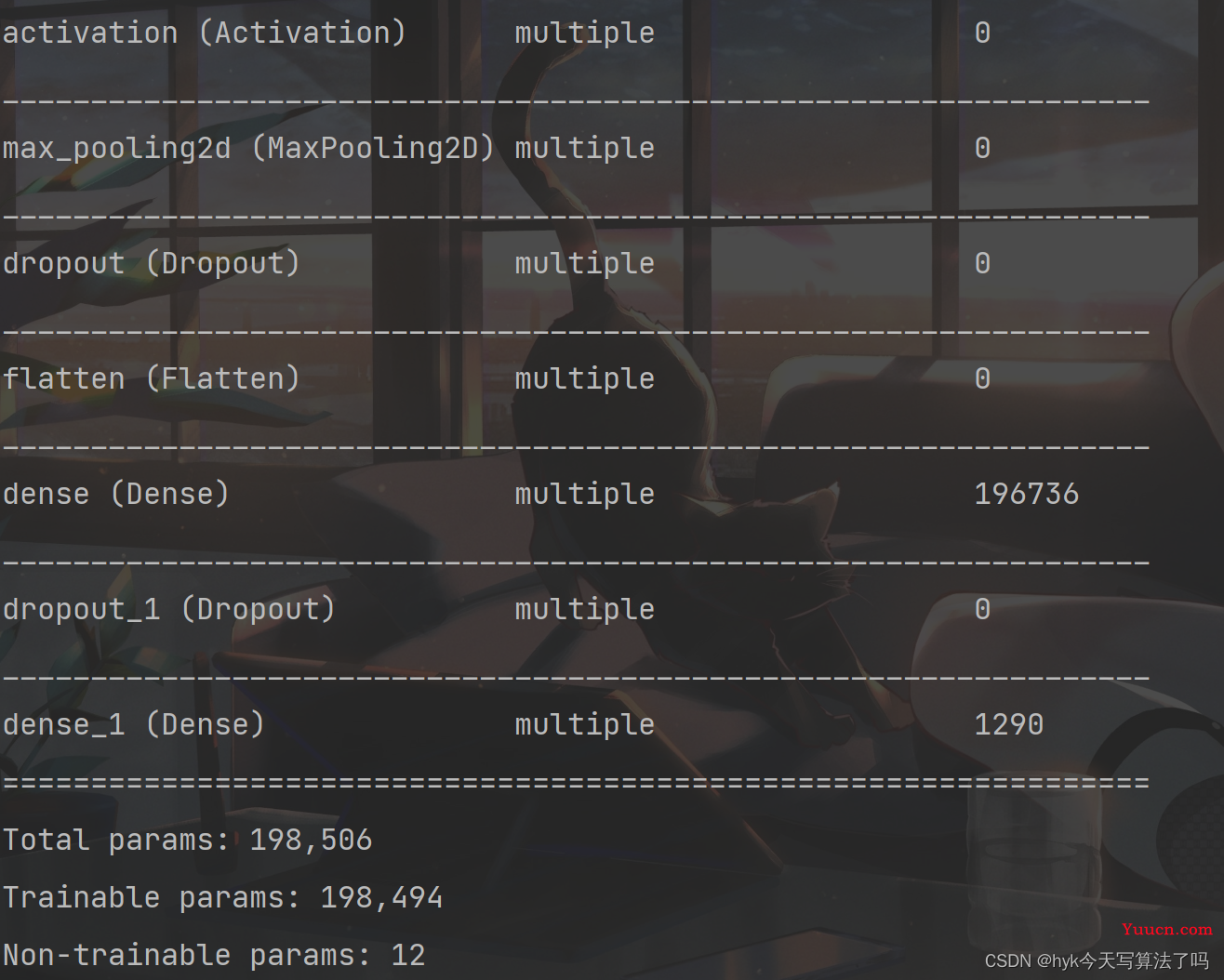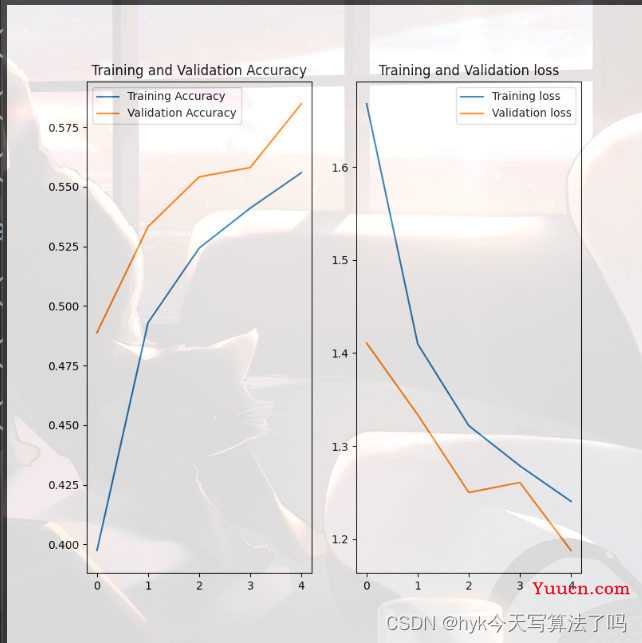🍅 写在前面
👨🎓 博主介绍:大家好,这里是hyk写算法了吗,一枚致力于学习算法和人工智能领域的小菜鸟。
🔎个人主页:主页链接(欢迎各位大佬光临指导)
⭐️近期专栏:机器学习与深度学习
LeetCode算法实例
目录
- 总览
- 数据集简介
- 第三方库准备
- 加载数据
- 搭建cnn模型类以及相关方法
- 训练模型
- 画图展示结果
- 项目整体代码
- 运行结果
- 部分知识点整理
-
- 模型建立
- model.compile
- 训练模型
- 打印网络结构和参数统计
总览
本节内容主要向大家介绍如何使用TensorFlow快速搭建自己的卷积神经网络,并通过cifar数据集训练验证。文章最后会有相关内容知识点的补给。
数据集简介
Cifar-10 是由 Hinton 的学生 Alex Krizhevsky、Ilya Sutskever 收集的一个用于普适物体识别的计算机视觉数据集,它包含 60000 张 32 X 32 的 RGB 彩色图片,总共 10 个分类。其中,包括 50000 张用于训练集,10000 张用于测试集。

第三方库准备
import tensorflow as tf
import numpy as np
from matplotlib import pyplot as plt
该项目使用上述第三方库,大家提前下载需要提前下载好。
加载数据
cifar10 = tf.keras.datasets.cifar10
(x_train, y_train), (x_test, y_test) = cifar10.load_data()
x_train, x_test = x_train / 255.0, x_test / 255.0
首次使用需要联网下载一段时间数据集,大家耐心等待下。
搭建cnn模型类以及相关方法
# 继承自tf.keras.Model
class Baseline(tf.keras.Model):
def __init__(self):
super(Baseline, self).__init__()
# 第一层卷积
self.c1 = tf.keras.layers.Conv2D(filters=6, kernel_size=(5, 5), padding='same')
# 第一层BN
self.b1 = tf.keras.layers.BatchNormalization()
# 激活函数层
self.a1 = tf.keras.layers.Activation('relu')
# 池化层
self.p1 = tf.keras.layers.MaxPool2D(pool_size=(2, 2), strides=2, padding='same')
# Dropout层
self.d1 = tf.keras.layers.Dropout(0.2)
# 将卷积获得的网络拉平以便后序全连接层使用
self.flatten = tf.keras.layers.Flatten()
# 一层全连接
self.f1 = tf.keras.layers.Dense(128, activation='relu')
# 又一层dropout
self.d2 = tf.keras.layers.Dropout(0.2)
# 第二层全连接
self.f2 = tf.keras.layers.Dense(10, activation='softmax')
# 读入inputs数据,并进行操作返回
def call(self, inputs):
x = self.c1(inputs)
x = self.b1(x)
x = self.a1(x)
x = self.p1(x)
x = self.d1(x)
x = self.flatten(x)
x = self.f1(x)
x = self.d2(x)
y = self.f2(x)
return y
训练模型
# 创建模型对象
model = Baseline()
# 指明优化器、损失函数、准确率计算函数
model.compile(optimizer=tf.keras.optimizers.Adam(),
loss=tf.keras.losses.SparseCategoricalCrossentropy(from_logits=False),
metrics=[tf.keras.metrics.sparse_categorical_accuracy])
# 开始训练
history = model.fit(x_train, y_train, batch_size=32, epochs=5, validation_data=(x_test, y_test), validation_freq=1)
# 展示训练的过程
model.summary()
画图展示结果
# show
acc = history.history['sparse_categorical_accuracy']
val_acc = history.history['val_sparse_categorical_accuracy']
loss = history.history['loss']
val_loss = history.history['val_loss']
print(acc)
print(val_loss)
plt.figure(figsize=(8, 8))
plt.subplot(1, 2, 1)
plt.plot(acc, label='Training Accuracy')
plt.plot(val_acc, label='Validation Accuracy')
plt.title('Training and Validation Accuracy')
plt.legend()
plt.subplot(1, 2, 2)
plt.plot(loss, label='Training loss')
plt.plot(val_loss, label='Validation loss')
plt.title('Training and Validation loss')
plt.legend()
plt.show()
分别展示了训练集和测试集上精确度、损失值的对比
项目整体代码
import tensorflow as tf
import numpy as np
from matplotlib import pyplot as plt
np.set_printoptions(threshold=np.inf)
cifar10 = tf.keras.datasets.cifar10
(x_train, y_train), (x_test, y_test) = cifar10.load_data()
x_train, x_test = x_train / 255.0, x_test / 255.0
class Baseline(tf.keras.Model):
def __init__(self):
super(Baseline, self).__init__()
self.c1 = tf.keras.layers.Conv2D(filters=6, kernel_size=(5, 5), padding='same')
self.b1 = tf.keras.layers.BatchNormalization()
self.a1 = tf.keras.layers.Activation('relu')
self.p1 = tf.keras.layers.MaxPool2D(pool_size=(2, 2), strides=2, padding='same')
self.d1 = tf.keras.layers.Dropout(0.2)
self.flatten = tf.keras.layers.Flatten()
self.f1 = tf.keras.layers.Dense(128, activation='relu')
self.d2 = tf.keras.layers.Dropout(0.2)
self.f2 = tf.keras.layers.Dense(10, activation='softmax')
def call(self, inputs):
x = self.c1(inputs)
x = self.b1(x)
x = self.a1(x)
x = self.p1(x)
x = self.d1(x)
x = self.flatten(x)
x = self.f1(x)
x = self.d2(x)
y = self.f2(x)
return y
model = Baseline()
model.compile(optimizer=tf.keras.optimizers.Adam(),
loss=tf.keras.losses.SparseCategoricalCrossentropy(from_logits=False),
metrics=[tf.keras.metrics.sparse_categorical_accuracy])
history = model.fit(x_train, y_train, batch_size=32, epochs=5, validation_data=(x_test, y_test), validation_freq=1)
model.summary()
# show
acc = history.history['sparse_categorical_accuracy']
val_acc = history.history['val_sparse_categorical_accuracy']
loss = history.history['loss']
val_loss = history.history['val_loss']
print(acc)
print(val_loss)
plt.figure(figsize=(8, 8))
plt.subplot(1, 2, 1)
plt.plot(acc, label='Training Accuracy')
plt.plot(val_acc, label='Validation Accuracy')
plt.title('Training and Validation Accuracy')
plt.legend()
plt.subplot(1, 2, 2)
plt.plot(loss, label='Training loss')
plt.plot(val_loss, label='Validation loss')
plt.title('Training and Validation loss')
plt.legend()
plt.show()
运行结果


部分知识点整理
模型建立
-
tf.keras.models.Sequential([网络结构]) # 描述各层网洛Sequentail()可以认为是个容器,这个容器里封装了一个神经网络结构。在Sequential中要描述从输入层到输出层每一层的网络结构。
每一层的网络结构可以是 - 拉直层: tf.keras.layers.Flatten() ,这一层不含计算,只是形状转换,把输入特征拉直,变成一维数组
- 全连接层:
tf.keras.layers.Dense(神经元个数,activation=“激活函数”,kernel_regularizer=哪种正则化),这一层告知神经元个数、使用什么激活函数、采用什么正则化方法 激活函数可以选择relu, softmax, sigmoid, tanh等 - 正则化可以选择 tf.keras.regularizers.l1(), tf.keras.relularizers.l2()
- 卷积神经网络层:tf.keras.layers.Conv2D(filters=卷积核个数,kernel_size=卷积核尺寸,strides=卷积步长, padding=“valid” or “same”)
- 循环神经网络层:tf.keras.layers.LSTM()
model.compile
model.compile(optimizer=优化器,loss=损失函数,metrics=["准确率"])在这里告知训练时选择的优化器、损失函数、和评测指标。 这些参数都可以使用字符串形式或函数形式
-
optimizer: 引导神经网络更新参数
- sgd or tf.keras.optimizer.SGD(lr=学习率,momentum=动量参数)
- adagrad or tf.keras.optimizer.Adagrad(lr=学习率)
- adadelta or tf.keras.optimizer.Adadelta(lr=学习率)
- adam or tf.keras.optimizer.Adam(lr=学习率, beta_1=0.9, beta_2=0.999)
-
loss: 损失函数
-
mes or tf.keras.losses.MeanSquaredError()
-
sparse_categorical_crossentropy or
tf.keras.SparseCategoricalCrossentropy(from_logits=False)(是原始输出还是经过概率分布)
-
-
metrics:评测指标
- accuracy:y_ 和 y 都是数值,如y_=[1] y=[1]
- categorical_accuracy: y_和y都是独热码(概率分布),如y_=[0, 1, 0], y=[0.256, 0.695,
0.048] - sparse_categorical_accuracy: y_是数值,y是独热码(概率分布),如y_=[1], y=[0.256,
0.695, 0.048]
训练模型
model.fit(训练集的输入特征,训练集的标签,batch_size= 每次喂入神经网络的样本数, epochs=迭代多少次数据集, validation_data=(测试集的输入特征,测试集的标签,), validation_split=从训练集划分多少比例给测试集,validation_freq=多少次epoch测试一次)
打印网络结构和参数统计
model.summary()